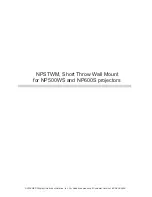
If you are unable to clearly identify some or all of the wires identified in step 2 of
the instructions, you should consult with a qualified electrician.
Steps 4a, 4b, and 4c describe each circuit application.
For information about other applications, consult technical support or the
WattStopper website.
1. Prepare the switch box.
After the power is turned OFF at the circuit breaker box, remove the existing
wall plate and mounting screws. Pull the old switch out from the wall box.
2. Identify the type of circuit.
You may connect the RD‑250 to a single pole (see
Fig. 2) or 3‑way circuit (see Fig. 2a).
In a 3‑way circuit, two traveler wires connect
to both switches. Another wire provides power
from the circuit box to one of the switches. A wire
connects from one switch to the load. A ground
wire may also be connected to a ground terminal
on the old switches. A neutral wire should also be
present in both wall boxes.
NEUTRAL
GROUND
LOAD/Common
(power to lamp)
NEUTRAL
GROUND
HOT/Common
(power from circuit box)
TRAVELER
TRAVELER
Lamp/load
MASTER SWITCH
AUXILIARY SWITCH
Fig. 2a: Typical 3‑way Switch Wiring
3. Prepare the Wires.
Tag the wires currently connected to the existing switch so that they can be
identified later. Disconnect the wires. Make sure the insulation is stripped off
of the wires to expose their copper cores to the length indicated by the “Strip
Gage,” in Fig. 3. (approx. 1/2 inch).
For your safety: Connecting a proper
ground to the sensor provides protection
against electrical shock in the event of
certain fault conditions. If a proper ground
is not available, consult with a qualified
electrician before continuing installation.
4a. Single pole wiring:
Twist the existing wires together with the wire leads on the RD‑250 sensor as
indicated below. Cap them securely using the wire nuts provided (See Fig 4a).
• Connect the green or non‑insulated (copper) GROUND wire from the circuit to
the green wire on the RD‑250.
*URXQG
+27SRZHUIURP
FLUFXLWER[
/2$'
SRZHU
WRODPS
1(875$/
Fig. 2: Typical Single
Pole Switch
Strip Gage
1/2"
12.7 mm
Fig. 3: Wire Stripping
CAUTION — WARNING
To reduce the risk of overheating and possible damage
to other equipment, do not install to control a receptacle,
a motor‑operated appliance, a fluorescent lighting
fixture, or a transformer‑supplied appliance.
Disconnect power to the wall switch box by turning OFF
the circuit breaker or removing the fuse for the circuit before
installing the RD‑250, replacing lamps, or doing any electrical work.
Call 800.879.8585 for Technical Support


























